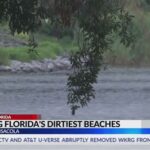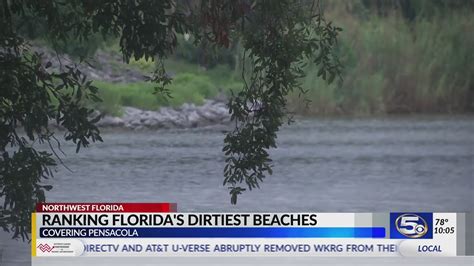
A Florida beach has earned the unwelcome distinction of being the state’s germiest and among the nation’s worst for bacteria levels, according to a recent study by Environment America Research & Policy Center.
A new report released by Environment America Research & Policy Center and Frontier Group has identified Bahia Honda State Park’s Calusa Beach as having some of the highest bacteria levels in Florida and ranking poorly nationwide, based on data collected in 2023. The study, titled “Safe for Swimming?,” analyzed water quality test results from beaches across the country, revealing potentially unsafe conditions for swimmers at numerous locations.
Calusa Beach, a popular tourist destination in the Florida Keys, recorded bacteria levels exceeding the U.S. Environmental Protection Agency’s (EPA) benchmark for safe swimming on 71% of the days it was tested in 2023. This high percentage raises concerns about potential health risks for beachgoers, including gastrointestinal illnesses, skin infections, and other waterborne diseases. The alarming statistics has prompted environmental groups and public health advocates to call for increased monitoring, improved infrastructure, and better public notification systems to protect swimmers from contaminated waters. The presence of high bacteria levels often indicates fecal contamination, which can stem from various sources, including sewage overflows, agricultural runoff, and stormwater runoff. Such contamination poses significant risks not only to human health but also to the delicate marine ecosystem.
The “Safe for Swimming?” report examined data from nearly 3,200 beach sites across 29 states and Puerto Rico. The analysis focused on fecal indicator bacteria, which signal the potential presence of harmful pathogens. According to the report, approximately 55% of the sites tested had at least one day in 2023 when bacteria levels exceeded the EPA’s “benchmark” level of 32 colony forming units (CFU) per 100 milliliters of water. The EPA’s benchmark is considered unsafe for swimming.
“Our report finds that bacteria pollution is all too common at beaches across the country,” said John Rumpler, clean water director for Environment America Research & Policy Center. “Sewage overflows and polluted runoff put swimmers at risk and threaten the coastal economy.”
While Calusa Beach stood out in Florida, the report highlighted that other beaches in the state also faced challenges with bacterial contamination. The findings underscore the need for comprehensive strategies to address pollution sources and safeguard public health at coastal recreational areas.
“Florida’s beaches are a vital part of our state’s identity and economy,” said Ashley Rusnak, a conservation advocate with Florida PIRG, a consumer advocacy group. “It is crucial that we take proactive steps to protect these natural resources from pollution and ensure that they are safe for everyone to enjoy.”
The report recommends several measures to mitigate beach pollution, including investing in wastewater infrastructure upgrades, implementing stricter regulations on agricultural runoff, and expanding monitoring and notification programs. The advocates emphasize the importance of public awareness, urging beachgoers to check water quality advisories and take precautions to minimize their risk of exposure to contaminated water.
The Florida Department of Health conducts regular water quality testing at beaches throughout the state and issues advisories when bacteria levels exceed safety standards. However, environmental groups argue that the current monitoring system is inadequate and that more frequent testing is needed to provide timely and accurate information to the public. They also advocate for enhanced enforcement of existing environmental regulations to prevent pollution from reaching beaches in the first place. The economic implications of beach closures and advisories are also significant. Coastal tourism contributes billions of dollars to Florida’s economy each year, and concerns about water quality can deter visitors and negatively impact local businesses. Therefore, investing in clean water infrastructure and pollution prevention measures is not only essential for public health but also for the state’s economic well-being.
The Environment America Research & Policy Center and Frontier Group report serves as a reminder of the ongoing challenges in protecting coastal waters from pollution and the importance of proactive measures to ensure that beaches remain safe and enjoyable for all. Further investigation is warranted to pinpoint the sources of contamination at Calusa Beach and implement targeted solutions to address the problem. The state and local authorities must work collaboratively with environmental organizations and community stakeholders to develop and implement comprehensive strategies to protect Florida’s beaches and safeguard public health.
Deep Dive into the Report Findings:
The “Safe for Swimming?” report offers a detailed look at the state of beach water quality across the United States. The study utilizes data collected by state and local agencies responsible for monitoring beach water quality, focusing specifically on the presence of fecal indicator bacteria. These bacteria, such as Enterococcus and E. coli, are not necessarily harmful themselves, but their presence indicates that fecal contamination may have occurred, raising the risk of exposure to disease-causing pathogens. The EPA has established recreational water quality criteria (RWQC) for these indicator bacteria, providing a benchmark for assessing the safety of swimming waters. The report uses these criteria to determine the percentage of days that beaches exceed the safe threshold for swimming.
The report’s findings reveal significant variations in beach water quality across different regions and states. While some areas consistently maintain low bacteria levels, others experience frequent exceedances of the EPA’s benchmarks. Factors contributing to these variations include the effectiveness of wastewater treatment systems, the prevalence of agricultural activities, the intensity of rainfall events, and the density of human populations. Urban areas with aging infrastructure often struggle with sewage overflows, which can release untreated wastewater directly into waterways, contaminating beaches and posing serious health risks. Agricultural areas, particularly those with concentrated animal feeding operations (CAFOs), may experience runoff containing manure and fertilizers, which can introduce bacteria and other pollutants into coastal waters. Stormwater runoff, especially in urban areas, can also carry pollutants from streets, parking lots, and construction sites, further contributing to beach contamination.
In addition to highlighting specific beaches with high bacteria levels, the report also examines the overall trends in beach water quality over time. While some areas have shown improvement in recent years, others have experienced a decline, underscoring the need for continued vigilance and investment in pollution control measures. The report emphasizes that addressing beach pollution requires a multi-faceted approach that tackles the root causes of contamination. This includes upgrading wastewater infrastructure, implementing best management practices for agriculture, promoting sustainable urban development, and enforcing environmental regulations.
The Specific Case of Calusa Beach:
The identification of Calusa Beach as one of the germiest beaches in Florida and the nation raises specific concerns about the factors contributing to its high bacteria levels. Calusa Beach is located within Bahia Honda State Park, a popular destination for swimming, snorkeling, and other water-based activities. The park is known for its pristine beaches and clear waters, making the high bacteria levels at Calusa Beach particularly alarming.
Several potential sources of contamination may be contributing to the problem at Calusa Beach. One possibility is that sewage from nearby residential or commercial areas is leaking into the groundwater and eventually reaching the beach. Another potential source is boat waste, as the area is popular for boating and fishing. Inadequate waste disposal practices on boats can lead to the release of sewage into the water, contributing to bacterial contamination. Wildlife, such as birds and other animals, can also contribute to fecal contamination, particularly if their populations are concentrated in certain areas. Additionally, stormwater runoff from the surrounding land may be carrying pollutants into the beach.
Addressing the contamination at Calusa Beach will require a thorough investigation to identify the specific sources of the problem. This may involve conducting water quality testing at various locations around the beach, tracing the flow of groundwater, and assessing the potential impact of boat waste and wildlife. Once the sources of contamination are identified, targeted solutions can be implemented to address the problem. This may include repairing or upgrading sewage infrastructure, implementing stricter regulations on boat waste disposal, managing wildlife populations, and improving stormwater management practices.
The Broader Context of Beach Pollution in Florida:
While Calusa Beach has garnered attention for its high bacteria levels, it is important to recognize that beach pollution is a widespread problem in Florida. The state’s extensive coastline, large population, and heavy tourism contribute to the challenges of maintaining clean and safe beaches. Several factors contribute to beach pollution in Florida, including:
-
Aging Infrastructure: Many of Florida’s wastewater treatment plants and sewage systems are aging and in need of repair or replacement. This can lead to leaks and overflows, which release untreated wastewater into waterways, contaminating beaches and posing health risks.
-
Agricultural Runoff: Agriculture is a major industry in Florida, and agricultural runoff containing fertilizers, pesticides, and animal waste can contribute to beach pollution. Nutrients from fertilizers can fuel algal blooms, which can deplete oxygen in the water and harm marine life. Animal waste can introduce bacteria and pathogens into the water, posing health risks to swimmers.
-
Stormwater Runoff: Florida is prone to heavy rainfall events, and stormwater runoff can carry pollutants from streets, parking lots, and construction sites into beaches. This runoff can contain bacteria, oil, grease, and other contaminants that degrade water quality and pose health risks.
-
Boat Waste: Florida is a popular destination for boating, and inadequate waste disposal practices on boats can contribute to beach pollution. Sewage from boats can release bacteria and pathogens into the water, posing health risks to swimmers.
-
Red Tide: Red tide is a naturally occurring phenomenon in Florida waters, caused by blooms of algae that produce toxins. These toxins can harm marine life and cause respiratory irritation in humans. While red tide is not directly related to fecal contamination, it can exacerbate the health risks associated with swimming in contaminated waters.
Addressing beach pollution in Florida requires a comprehensive approach that tackles all of these factors. This includes investing in infrastructure upgrades, implementing best management practices for agriculture, improving stormwater management, regulating boat waste disposal, and monitoring and mitigating red tide events.
The Role of Monitoring and Notification Programs:
Regular monitoring and notification programs are essential for protecting public health at beaches. These programs involve collecting water samples at beaches and testing them for fecal indicator bacteria. When bacteria levels exceed safety standards, advisories are issued to warn the public about the potential health risks of swimming in the water.
The Florida Department of Health conducts regular water quality testing at beaches throughout the state and issues advisories when bacteria levels exceed safety standards. However, environmental groups argue that the current monitoring system is inadequate and that more frequent testing is needed to provide timely and accurate information to the public. They also advocate for enhanced enforcement of existing environmental regulations to prevent pollution from reaching beaches in the first place.
In addition to monitoring and notification programs, public education is also crucial for protecting beachgoers. Beachgoers should be informed about the potential health risks of swimming in contaminated waters and advised to take precautions to minimize their risk of exposure. These precautions may include avoiding swimming after heavy rainfall, avoiding swimming near storm drains or pipes, and showering after swimming.
The Economic Impact of Beach Pollution:
Beach pollution can have significant economic impacts, particularly in tourism-dependent states like Florida. Beach closures and advisories can deter visitors and negatively impact local businesses. Concerns about water quality can also affect property values and reduce the attractiveness of coastal communities.
Coastal tourism contributes billions of dollars to Florida’s economy each year, and clean and safe beaches are essential for attracting visitors. Investing in clean water infrastructure and pollution prevention measures is not only essential for public health but also for the state’s economic well-being.
The Importance of Proactive Measures:
Preventing beach pollution requires proactive measures to address the root causes of contamination. This includes investing in wastewater infrastructure upgrades, implementing stricter regulations on agricultural runoff, improving stormwater management, and regulating boat waste disposal. It also includes promoting sustainable development practices that minimize pollution and protect coastal resources.
Proactive measures are more cost-effective than reactive measures, such as cleaning up polluted beaches after contamination has occurred. By preventing pollution in the first place, we can protect public health, safeguard the environment, and preserve the economic benefits of clean and healthy beaches.
The Need for Collaboration:
Addressing beach pollution requires collaboration among government agencies, environmental organizations, community groups, and individual citizens. Government agencies play a crucial role in setting and enforcing environmental regulations, monitoring water quality, and investing in infrastructure upgrades. Environmental organizations provide scientific expertise, advocate for policy changes, and educate the public about the importance of protecting coastal resources. Community groups and individual citizens can participate in beach cleanups, monitor local water quality, and advocate for stronger environmental protections.
By working together, we can ensure that Florida’s beaches remain clean, safe, and enjoyable for all.
Looking Ahead:
The “Safe for Swimming?” report serves as a reminder of the ongoing challenges in protecting coastal waters from pollution and the importance of proactive measures to ensure that beaches remain safe and enjoyable for all. Further investigation is warranted to pinpoint the sources of contamination at Calusa Beach and implement targeted solutions to address the problem. The state and local authorities must work collaboratively with environmental organizations and community stakeholders to develop and implement comprehensive strategies to protect Florida’s beaches and safeguard public health. The fight for clean beaches is a continuous effort, requiring sustained commitment and collaboration to achieve lasting results. It necessitates a shift towards more sustainable practices, responsible resource management, and a greater awareness of the impact of human activities on coastal environments. Only through collective action can we safeguard these precious ecosystems for future generations.
Frequently Asked Questions (FAQs):
-
Why is Calusa Beach considered one of the germiest beaches in Florida?
Calusa Beach was found to have bacteria levels exceeding the EPA’s benchmark for safe swimming on 71% of the days it was tested in 2023, according to the Environment America Research & Policy Center report. This high percentage indicates a significant risk of exposure to harmful pathogens for swimmers.
-
What are the potential health risks associated with swimming in water with high bacteria levels?
Swimming in contaminated water can lead to various health problems, including gastrointestinal illnesses (such as diarrhea and vomiting), skin infections, respiratory infections, and ear and eye infections. The specific risks depend on the type and concentration of bacteria present in the water.
-
What are the possible sources of bacteria contamination at Calusa Beach?
Potential sources of contamination include sewage leaks or overflows from nearby residential or commercial areas, boat waste from recreational boating activities, wildlife (such as birds) contributing fecal matter, and stormwater runoff carrying pollutants from the surrounding land.
-
What is being done to address the bacteria problem at Calusa Beach?
Addressing the problem requires a thorough investigation to identify the specific sources of contamination. This may involve water quality testing, tracing groundwater flow, and assessing the impact of boat waste and wildlife. Targeted solutions may include repairing sewage infrastructure, regulating boat waste disposal, managing wildlife populations, and improving stormwater management practices.
-
How can I stay safe when swimming at Florida beaches?
To minimize your risk, check water quality advisories before swimming, avoid swimming after heavy rainfall, avoid swimming near storm drains or pipes, and shower after swimming. Stay informed about beach conditions and heed any warnings or closures issued by local authorities.









